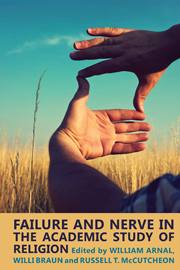Book contents
- Frontmatter
- Content
- Preface
- Acknowledgments
- Contributors
- Epigraph
- The Nerve of Donald Wiebe
- The Failure of Nerve in the Academic Study of Religion
- General Failures
- Special Failures
- Failures (of Nerve?) in the Study of Islamic Origins
- The Failure of Islamic Studies Post-9/11: A Contextualization and Analysis
- Religious Studies that Really Schmecks: Introducing Food to the Academic Study of Religion
- Cultural Anthropology and Corinthian Food Fights: Structure and History in the Lord's Dinner
- The Identity of Q in the First Century: Reproducing a Theological Narrative
- The Failure of Nerve to Recognize Violence in Early Christianity: The Case of the Parable of the Assassin
- Redescribing Iconoclasm: Holey Frescoes and Identity Formation
- In Lieu of Conclusion
- Index of Authors
Redescribing Iconoclasm: Holey Frescoes and Identity Formation
from Special Failures
- Frontmatter
- Content
- Preface
- Acknowledgments
- Contributors
- Epigraph
- The Nerve of Donald Wiebe
- The Failure of Nerve in the Academic Study of Religion
- General Failures
- Special Failures
- Failures (of Nerve?) in the Study of Islamic Origins
- The Failure of Islamic Studies Post-9/11: A Contextualization and Analysis
- Religious Studies that Really Schmecks: Introducing Food to the Academic Study of Religion
- Cultural Anthropology and Corinthian Food Fights: Structure and History in the Lord's Dinner
- The Identity of Q in the First Century: Reproducing a Theological Narrative
- The Failure of Nerve to Recognize Violence in Early Christianity: The Case of the Parable of the Assassin
- Redescribing Iconoclasm: Holey Frescoes and Identity Formation
- In Lieu of Conclusion
- Index of Authors
Summary
[T]he “critical insider” and “sympathetic outsider” converge, and ought to do so, only on the descriptive level but need not necessarily do so on the explanatory/theoretical level of that study.
(Wiebe 1984: 421 [26])For the last several years I have been the local coordinator for a study abroad trip made by students from the University of Alabama to Thessaloniki, Greece. During the trips we visited many sites of archaeological interest; one such site was a Byzantine church dating to the fourteenth century C.E., located within the old city's walls in the upper part of Thessaloniki. When the students entered the church, the first things that attracted their amazed attention were the pitted frescoes that cover the interior of the church's walls. Their primary (and urgent) question was who damaged the frescoes, and why. For me, by contrast, the church's pitted iconography had become so familiar that I no longer even pondered the damage, and only when prompted by the students’ curiosity did I realize that a whole discourse was up and running about the holes in that small church at the top of my city. And so I learned firsthand what Durkheim wrote in The Elementary Forms of Religious Life (1995: 54): “Habit easily puts curiosity to sleep and we no longer even imagine querying ourselves. To shake off that torpor, practical needs, or at least very pressing theoretical interest, must attract our attention and turn it in that direction”.
- Type
- Chapter
- Information
- Failure and Nerve in the Academic Study of Religion , pp. 218 - 228Publisher: Acumen PublishingPrint publication year: 2012



